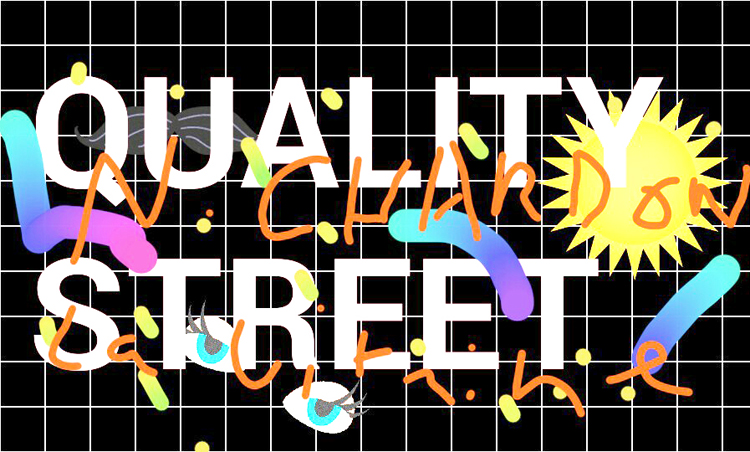Opening on Wednesday 4 November, from 7 to 9pm.
Abstract from a conversation between Nicolas Chardon and Gilles Baume
Gilles Baume: Your proposition for the Window Display is a contextual project, Quality Street, which you consider to be a public art piece, in that the window is a hybrid space, between the white, closed, museum wall and the opening onto the street. Does the presence of your art in the city via the various pieces you’ve developed in the public space – especially the project Quality Street – enable you to mark a desire to fit into what’s happening here and now, especially when one considers their relationship with surrounding urban visual codes?
Nicolas Chardon : When I exhibit a monochrome wooden panel in the street, for instance, I’m not doing so to shift its artistic quality, or even to exploit the artistic quality of the street itself, but rather to make the most of what I believe to be the blank quality of art when it’s shown in the street. I think anything is possible in the street, that everything is equal, that a simple wooden board can be seen both as a simple wooden board and as art, more so than in a museum or gallery (where one always suspects there will be art). Still, I won’t delude myself into thinking that my works are closer to the ‘real’ world because they happen to be shown in the street. My main interest is to show painting, and the street enables me to momentarily free it from artistic considerations and focus on other pictorial functions instead. Beyond the sugary nod, I chose to call the window display piece Quality Street because I wanted to underline the quality transfer that’s quite clearly happening nowadays, now that radical art melts in the mouth, and the cheapest, most mercantile, and aptly named street art has taken over the sphere of art.
GB: Your practice of abstraction refers to modernist language, especially in the way you use grid patterns. It brings up the question of the topicality of this kind of language nowadays. Next to the usual grid pattern that punctuates your work, the installation Quality Street also includes its own title, painted onto the window. Could you tell us more about what this title means to you, and perhaps give us a more general description of the relationship you establish between words and images?
NC: The relationship between texts and images is completely intertwined in my painting, and, as you mentioned, both derive from the structure of the grid. In a way, all the shapes that I paint come from language (the terminology of modernist painting, but not only), and my practice then consists in extracting them from it in order to try and make them visible. The same applies to the words ‘Peinture Abstraite’ (in all languages) or ‘ABSTRACT’, which I feature in my paintings. ABSTRACT is interesting in this respect, because it goes beyond the tautological effect, also evoking scientific or academic language, in which it designates the summary of a research – which perfectly matches the sort of curious synthesis my painting tends towards. A painting in which each gesture leads to its logical resolution by completely integrating modernist codes, while producing a form that is emancipated from the aesthetic dogma of the ‘proper’ form.
Therefore, Quality Street can be understood as a layering of my painting production, like an ABSTRACT: first a cotton canvas background, then a stretched canvas painted with a grid pattern, then painted shapes – often black and white – structured by the grid. What my paintings reveal – the distortion of the figures caused by the tension that the grid applies to the canvas – is a fertile paradox. The tension softens, rather than constrains. Quality Street must also be understood in light of this moral, and we must use the forms to pave a path that’ll lead us from the – tensed – space of art to the open, or perhaps freer, street.
The full text of this conversation is available here.
Street Cred. Some benchmarks :
– 68 – CAC Brétigny, 2007 + 68 (Reprise), CAC Brétigny, 2013
http://www.cacbretigny.com/inhalt/chardon.html
http://www.nicolaschardon.net/NC_site/context_b3.html
– Spazzio Pubblico, dans 7 rues de Rome, 2008
http://www.nicolaschardon.net/NC_site/context_d2.html
– ONZE RUE CLAVEL, La peinture à la rue, Biennale de Belleville, Paris, 2010 http://www.labiennaledebelleville.fr/2011/10/street-painting/
http://www.nicolaschardon.net/NC_site/context_e2.html
– ECHO, Frac Aquitaine, Bordeaux, 2011
http://www.frac-aquitaine.net/tout-ce-que-vous-avez-toujours-voulu-savoir-sur-le-blanc http://www.nicolaschardon.net/NC_site/context_i1.html
– Peintures blanches, Rue Bleue, Paris, 2011
http://www.nicolaschardon.net/NC_site/context_i3.html
– La peinture au balcon, Palette Terre, Paris, 2015
http://www.paletteterre.com/exhibitions_abstract.html
L’antenne culturelle
Située à 50 mètres du plateau
22 cours du 7e art
75019 Paris
